Product Quality during the Storage of Foods with Insects as an Ingredient: Impact of Particle Size, Antioxidant, Oil Content and Salt Content
Abstract
:1. Introduction
2. Aim
3. Materials and Methods
3.1. Material
3.2. Experimental Design
3.3. Production
3.4. Storage
3.5. Sensory Analysis
3.6. Instrumental Measurements
3.7. Statistical Analyses
4. Results
5. Discussion
6. Conclusions
Author Contributions
Funding
Acknowledgments
Conflicts of Interest
References
- van Huis, A. Potential of insects as food and feed in assuring food security. Annu. Rev. Entomol. 2013, 58, 563–583. [Google Scholar] [CrossRef] [PubMed]
- VanHuis, A.; Van Itterbeeck, J.; Klunder, H.; Mertens, E.; Halloran, A.; Muir, G.; Vantomme, P. Edible Insects: Future Prospects for Food and Feed Security (No. 171); Food and Agriculture Organization of the United Nations: Rome, Italy, 2013. [Google Scholar]
- Zhao, X.; Vázquez-Gutiérrez, J.L.; Johansson, D.P.; Landberg, R.; Langton, M. Yellow mealworm protein for food purposes-extraction and functional properties. PLoS ONE 2016, 11. [Google Scholar] [CrossRef] [PubMed] [Green Version]
- Elhassan, M.; Wendin, K.; Olsson, V.; Langton, M. Quality Aspects of Insects as Food—Nutritional, Sensory, and Related Concepts. Foods 2019, 8, 95. [Google Scholar] [CrossRef] [PubMed] [Green Version]
- Tan, H.S.G.; Fischer, A.R.; Tinchan, P.; Stieger, M.; Steenbekkers, L.P.A.; van Trijp, H.C. Insects as food: Exploring cultural exposure and individual experience as determinants of acceptance. Food Qual. Prefer. 2015, 42, 78–89. [Google Scholar] [CrossRef]
- Wendin, K.; Norman, C.; Forsberg, S.; Langton, M.; Davidsson, F.; Josell, Å.; Prim, M.; Berg, J. Eat’em or not? Insects as a culinary delicacy. In Proceedings of the 10th International Conference on Culinary Arts and Sciences, Copenhagen, Denmark, 6–7 July 2017; Mikkelsen, B., Ofei, K.T., Olsen Tvedebrink, T.D., Quinto Romano, A., Sudzina, F., Eds.; Aalborg University: Copenhagen, Denmark, 2017; pp. 100–106, ISBN 978-87-970462-0-3. [Google Scholar]
- Videbaek, P.N.; Grunert, K.G. Disgusting or delicious? Examining attitudinal ambivalence towards entomophagy among Danish consumers. Food Qual. Prefer. 2020, 83, 103913. [Google Scholar] [CrossRef]
- Azzollini, D.; Derossi, A.; Fogliano, V.; Lakemond, C.M.M.; Severini, C. Effects of formulation and process conditions on microstructure, texture and digestibility of extruded insect-riched snacks. Innov. Food Sci. Emerg. Technol. 2018, 45, 344–353. [Google Scholar] [CrossRef]
- Yi, L.; Lakemond, C.M.; Sagis, L.M.; Eisner-Schadler, V.; van Huis, A.; van Boekel, M.A. Extraction and characterisation of protein fractions from five insect species. Food Chem. 2013, 141, 3341–3348. [Google Scholar] [CrossRef]
- Lawless, H.; Heymann, H. Sensory Evaluation of Food–Principles and Practices, 2nd ed.; Springer: New York, NY, USA, 2010. [Google Scholar]
- Wendin, K.; Olsson, V.; Langton, M. Mealworms as Food Ingredient—Sensory Investigation of a Model System. Foods 2019, 8, 319. [Google Scholar] [CrossRef] [Green Version]
- Chen, N.; Zhao, M.; Chassenieux, C.; Nicolai, T. The effect of adding NaCl on thermal aggregation and gelation of soy protein isolate. Food Hydrocoll. 2017, 70, 88–95. [Google Scholar] [CrossRef]
- Zeb, A.; Ullah, F. A simple spectrophotometric method for the determination of thiobarbituric acid reactive substances in fried fast foods. J. Anal. Methods Chem. 2016, 1–5. [Google Scholar] [CrossRef] [Green Version]
- Khan, M.A.; Parrish, C.C.; Shahidi, F. Effects of mechanical handling, storage on ice and ascorbic acid treatment on lipid oxidation in cultured Newfoundland blue mussel (Mytilus edulis). Food Chem. 2006, 99, 605–614. [Google Scholar] [CrossRef]
- Morato, P.N.; Rodrigues, J.B.; Moura, C.S.; Silva, F.G.D.; Esmerino, E.A.; Cruz, A.G.; Lollo, P.C.B. Omega-3 enriched chocolate milk: A functional drink to improve health during exhaustive exercise. J. Funct. Foods 2015, 14, 676–683. [Google Scholar] [CrossRef]
- Dobermann, D.; Swift, J.A.; Field, L.M. Opportunities and hurdles of edible insects for food and feed. Nutr. Bull. 2017, 42, 293–308. [Google Scholar] [CrossRef] [Green Version]
- Simpson, R.; Jiménez, D.; Almonacid, S.; Nuñez, H.; Pinto, M.; Ramírez, C.; Vega-Castro, O.; Fuentes, L.; Angulo, A. Assessment and outlook of variable retort temperature profiles for the thermal processing of packaged foods: Plant productivity, product quality, and energy consumption. J. Food Eng. 2020, 275, 109839. [Google Scholar] [CrossRef]
- Kõrge, K.; Laos, K. The influence of different packaging materials and atmospheric conditions on the properties of pork rinds. J. Appl. Packag. Res. 2019, 11, 1. [Google Scholar]
- Tonneijck-Srpová, L.; Venturini, E.; Humblet-Hua, K.N.P.; Bruins, M.E. Impact of processing on enzymatic browning and texturization of yellow mealworms. J. Insects Food Feed 2019, 5, 267–276. [Google Scholar] [CrossRef]
- Naes, T.; Nyvold, T.E. Creative design—An efficient tool for product development. Food Qual. Prefer. 2004, 15, 97–104. [Google Scholar] [CrossRef]
- Teixeira, A.; Almeida, S.; Pereira, E.; Mangachaia, F.; Rodrigues, S. Physicochemical characteristics of sheep and goat pâtés. differences between fat sources and proportions. Heliyon 2019, 5, e02119. [Google Scholar] [CrossRef]
- Available online: http://orklafoodsrs.se/147585/ (accessed on 3 June 2020).
- Available online: https://ods.od.nih.gov/factsheets/Iron-HealthProfessional/ (accessed on 22 April 2020).
- Available online: https://ods.od.nih.gov/factsheets/Zinc-HealthProfessional/ (accessed on 22 April 2020).
- Food Processing Technology; Chapter 12 Heat sterilisation; Elsevier Ltd.: Amsterdam, The Netherlands, 2017. [CrossRef]
- ISO Standard 8586-2:2008. Sensory Analysis-General Guidance for the Selection, Training and Monitoring of Assessors—Part 2: Expert Sensory Assessors; International Organization for Standardization: Genève, Switzerland, 2008. [Google Scholar]
- CIE. Technical Report: Colorimetry; CIE: Washington, DC, USA, 2004. [Google Scholar]
- Meyer-Rochow, V.B. Can insects help to ease the problem of world food shortage. Search 1975, 6, 261–262. [Google Scholar]
- Rumpold, B.A.; Schlüter, O.K. Potential and challenges of insects as an innovative source for food and feed production. Innov. Food Sci. Emerg. Technol. 2013, 17, 1–11. [Google Scholar] [CrossRef]
- Freitas, M.A.; Costa, J.C. Shelf life determination using sensory evaluation scores: A general Weibull modeling approach. Comput. Ind. Eng. 2006, 51, 652–670. [Google Scholar] [CrossRef]
- Box, G.E.P.; Hunter, W.G.; Hunter, J.S. Statistics for Experimenters, an Introduction to Design, Data Analysis, and Model Building; John Wiley and Sons: New York, NY, USA, 1986. [Google Scholar]
- Erkan, N.; Ayranci, G.; Ayranci, E. Antioxidant activities of rosemary (Rosmarinus officinalis L.) extract, blackseed (Nigella sativa L.) essential oil, carnosic acid, rosmarinic acid and sesamol. Food Chem. 2008, 110, 76–82. [Google Scholar] [CrossRef] [PubMed]
- Aruoma, O.I.; Halliwell, B.; Aeschbach, R.; Löligers, J. Antioxidant and pro-oxidant properties of active rosemary constituents: Carnosol and carnosic acid. Xenobiotica 1992, 22, 257–268. [Google Scholar] [CrossRef] [PubMed]
- Jensen, S.; Oestdal, H.; Skibsted, L.H.; Larsen, E.; Thybo, A.K. Chemical changes in wheat pan bread during storage and how it affects the sensory perception of aroma, flavour, and taste. J. Cereal Sci. 2011, 53, 259–268. [Google Scholar] [CrossRef]
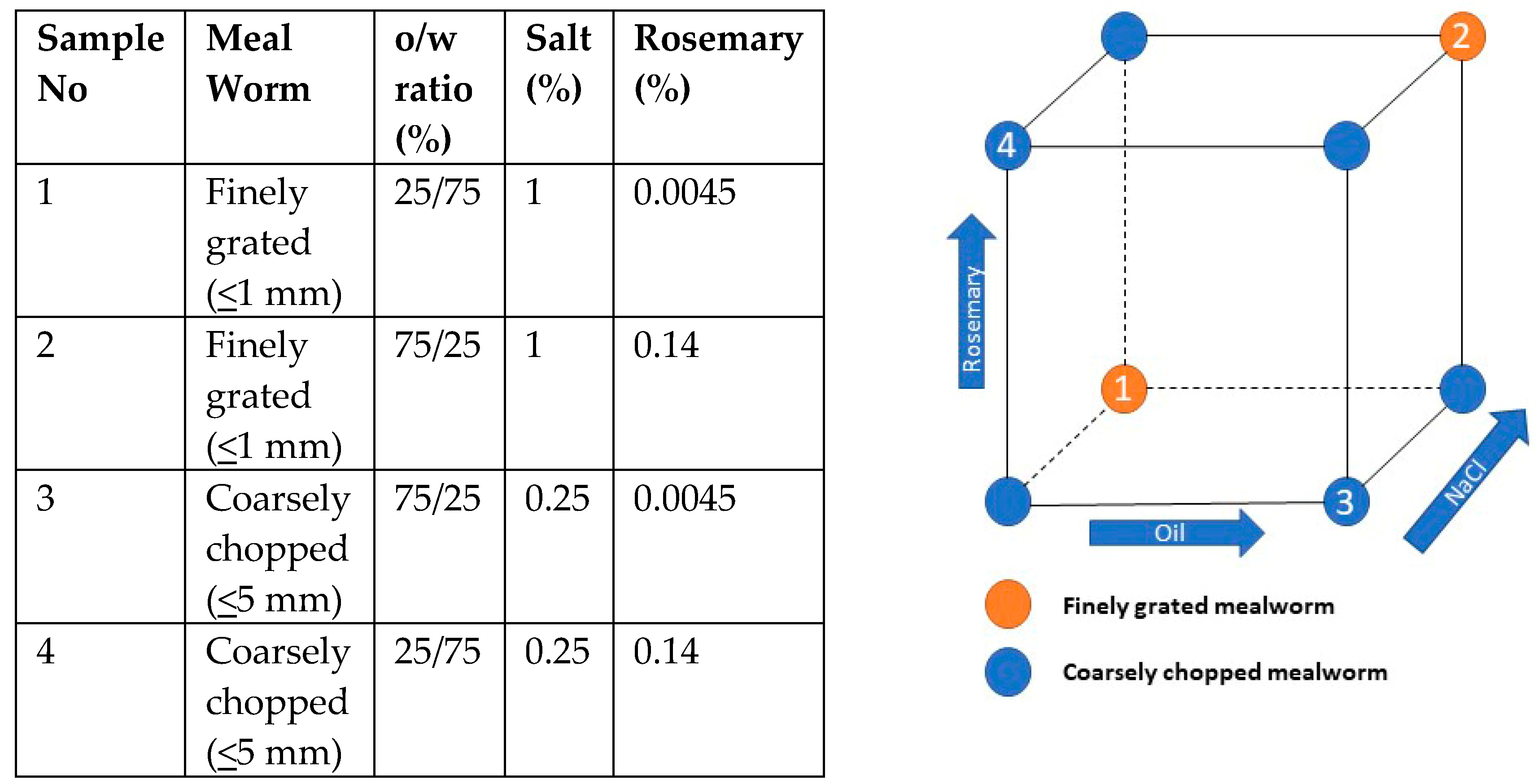
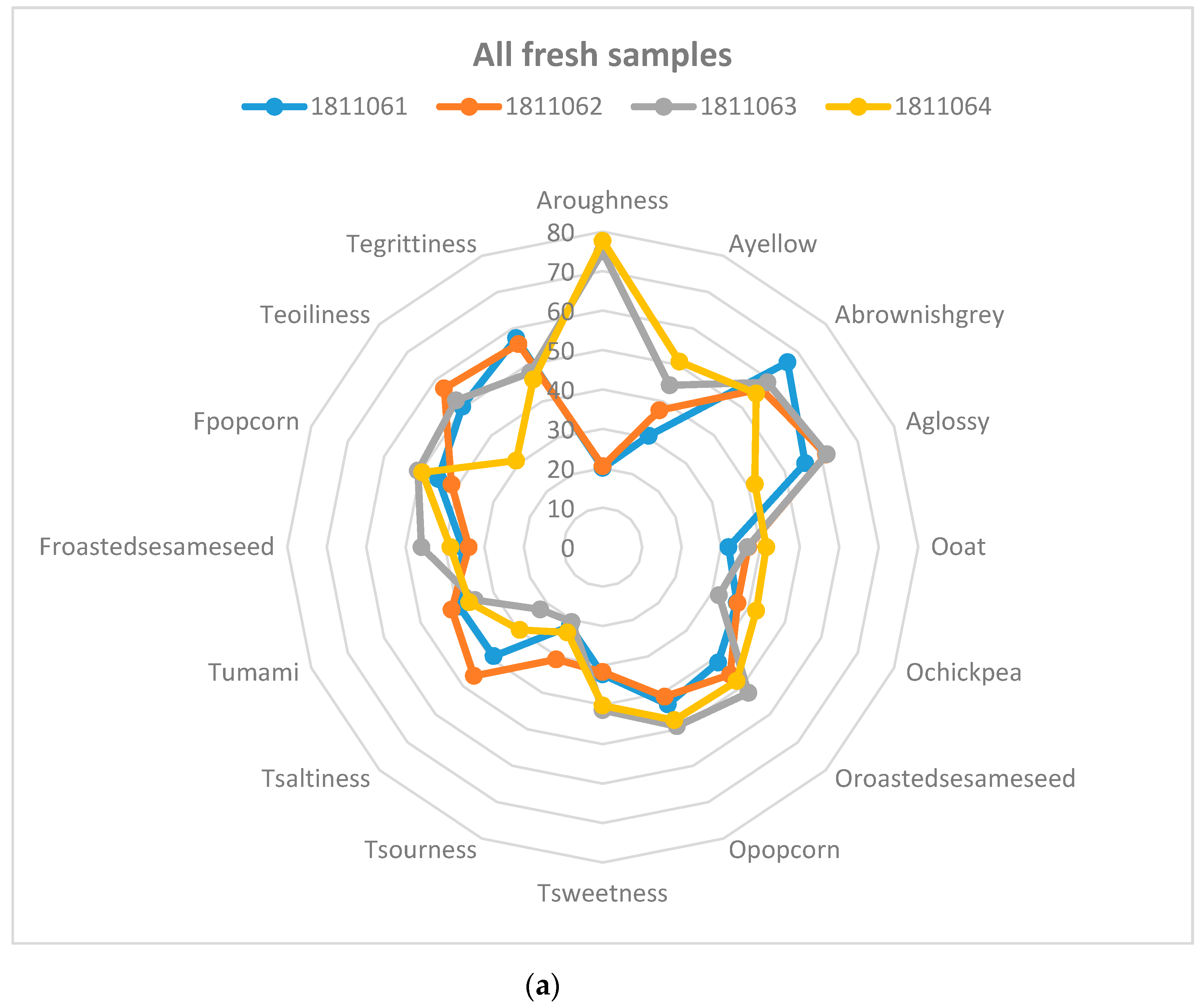
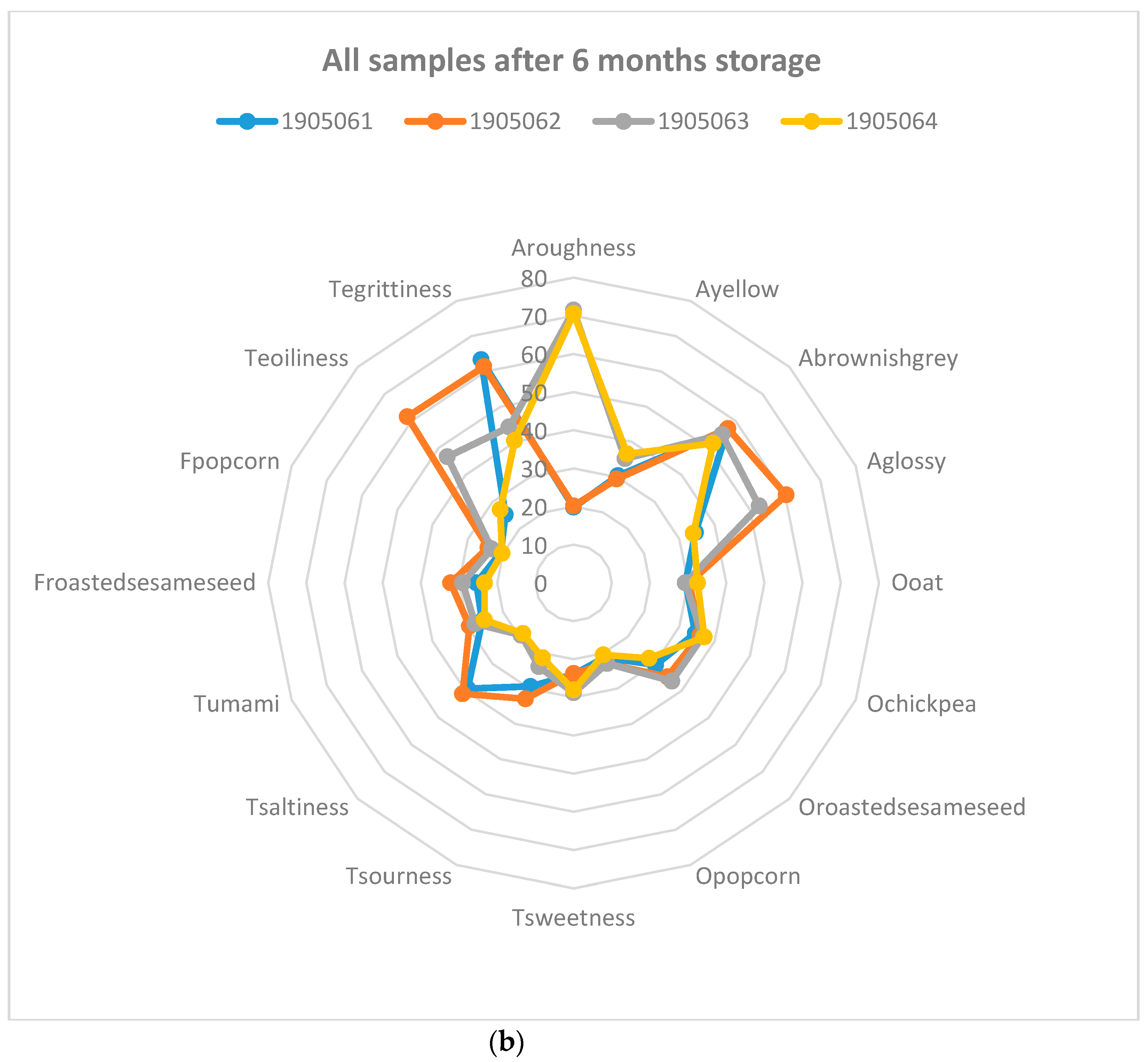

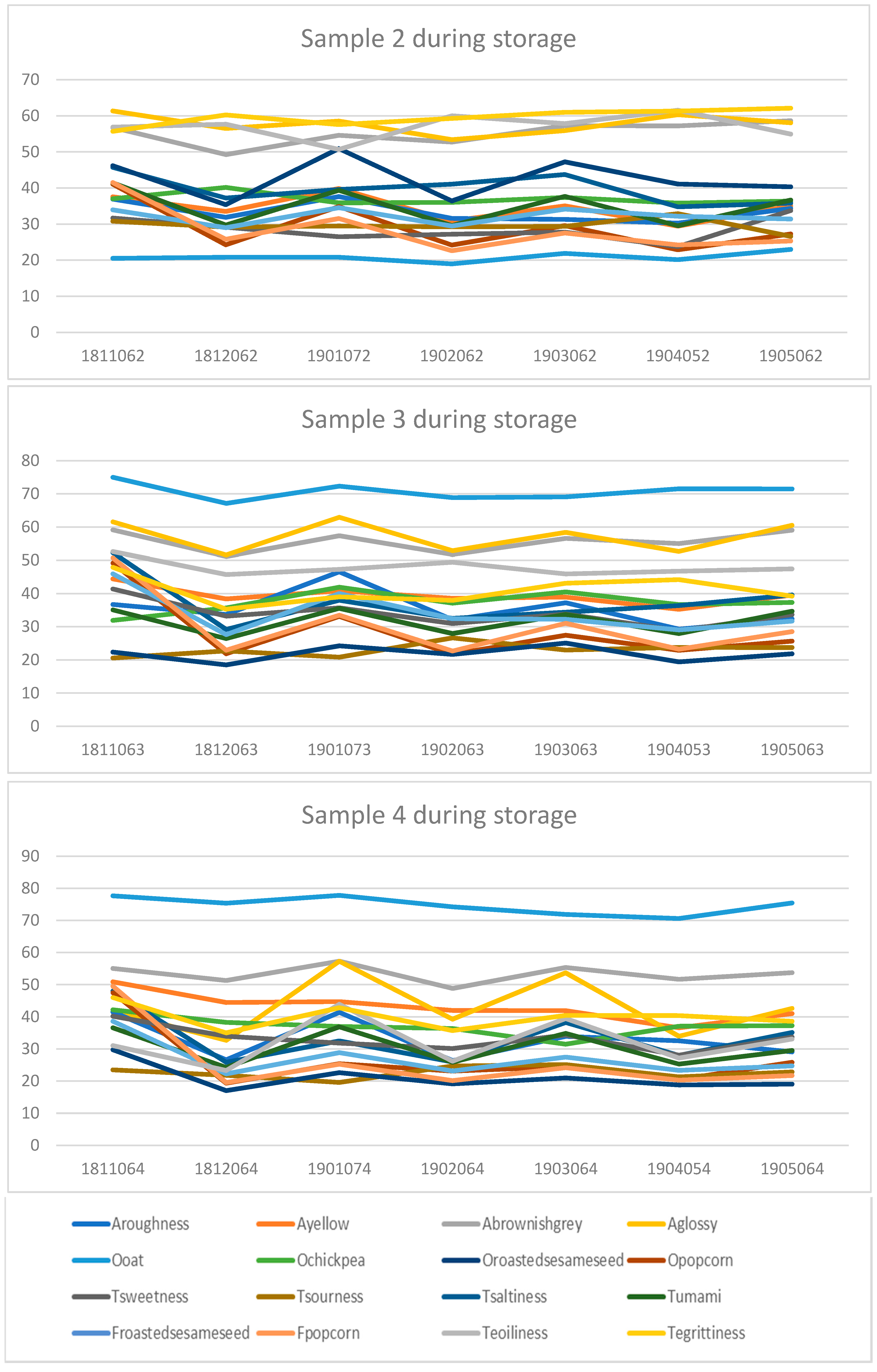
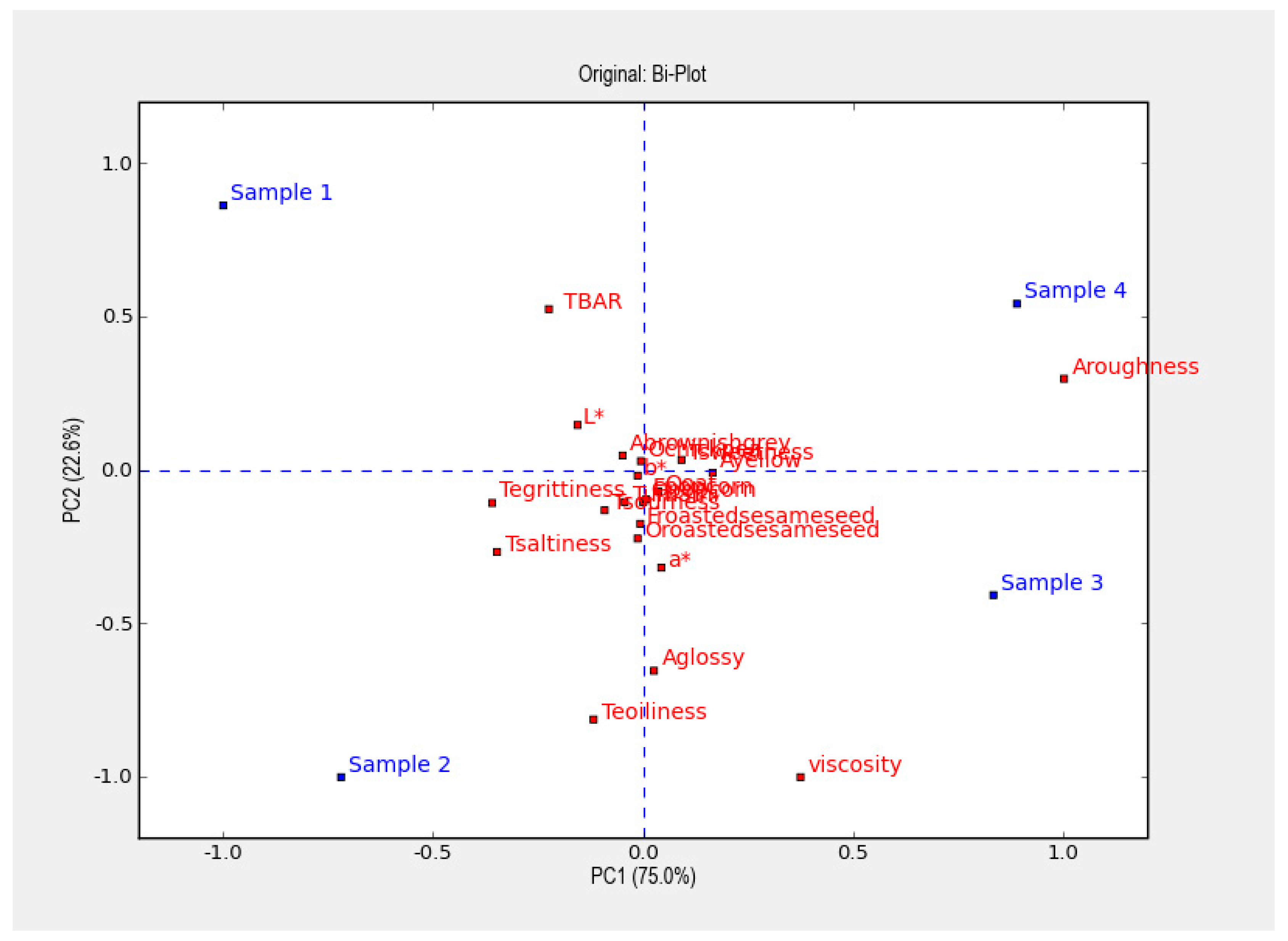
| Parameter | Mean Value (±) Standard Deviation |
|---|---|
| TS at 105 °C (%) 1 | 36.6 ± 2.0 |
| As (mg/kg) 2 | <0.006 |
| Cd (mg/kg) 2 | 0.0329 ± 0.0062 |
| Pb (mg/kg) 2 | <0.01 |
| Hg (mg/kg) 2 | <0.006 |
| Fe (mg/kg) 2 | 9.61 ± 2.09 |
| Zn (mg/kg) 2 | 33.8 ± 7.1 |
| Energy (kJ/100 g) 3 | 679 ± 48 |
| Energy (kcal/100 g) 3 | 162 ± 11 |
| Fat (g/100 g) 3 | 10.0 ± 0.50 |
| Saturated fat (g/100 g) 3 | 2.58 ± 0.77 |
| Monounsaturated fatty acids (g/100 g) 3 | 3.79 ± 1.14 |
| Polyunsaturated fatty acids (g/100 g) 3 | 3.17 ± 0.95 |
| Carbohydrate (g/100 g) 3 | 1.98 ± 0.14 |
| Fibre (g/100 g) 3 | 0.676 ± 0.135 |
| Protein (g/100 g) 3 | 15.8 ± 0.793 |
| Salt (g/100 g) 3 | 0.0892 ± 0.02 |
| Water (g/100 g) 3 | 70.5 ± 0.70 |
| Myristic acid (C14:0), (g/100 g fat) 4 | 2.95 ± 0.88 |
| Palmitic acid (C16:0), (g/100 g fat) 4 | 18.8 ± 5.64 |
| Steric acid (18:0), (g/100 g fat) 4 | 3.32 ± 1.00 |
| Oleic acid (C18:1n9c), (g/100 g fat) 4 | 36.2 ± 10.9 |
| Linoleic acid (C18:2n6c), (g/100 g fat) 4 | 30.1 ± 9.02 |
| Linolenic acid (C18:3n3), (g/100 g fat) 4 | 1.61 ± 0.48 |
| Omega 3 fatty acids, total fat (g/100 g fat) 4 | 1.61 ± 0.48 |
| Omega 6 fatty acids, total fat (g/100 g fat) 4 | 30.1 ± 9.02 |
| Omega 3 fatty acids, total (g/100 g) 4 | 0.16 ± 0.05 |
| Omega 6 fatty acids, total (g/100 g) 4 | 3.01 ± 0.90 |
| Process Data | Sample 1 | Sample 4 | Sample 2 | Sample 3 |
|---|---|---|---|---|
| Come-Up Time (min) | 21 | 21 | ||
| Holding Time (min) | 48 | 55 | ||
| Cooling Time (min) | 49 | 52 | ||
| Total Process Time (min) | 118 | 128 | ||
| F-value before cooling * | 20 | 49 | 30 | 30 |
| F-value Total * | 31 | 56 | 40 | 40 |
| Initial Temperature (°C) | 23 | 23 | ||
| End Temperature (°C) | 30 | 30 | ||
| Storage | Sample 1 | Sample 2 | Sample 3 | Sample 4 |
|---|---|---|---|---|
| Fresh | 181106-1 | 181106-2 | 181106-3 | 181106-4 |
| After 1 month | 181206-1 | 181206-2 | 181206-3 | 181206-4 |
| After 2 months | 190107-1 | 190107-2 | 190107-3 | 190107-4 |
| After 3 months | 190206-1 | 190206-2 | 190206-3 | 190206-4 |
| After 4 months | 190306-1 | 190306-2 | 190306-3 | 190306-4 |
| After 5 months | 190405-1 | 190405-2 | 190405-3 | 190405-4 |
| After 6 months | 190506-1 | 190506-2 | 190506-3 | 190506-4 |
| ATTRIBUTE | ABBREVIATION | DEFINITION |
|---|---|---|
| Appearance | ||
| Roughness | Aroughness | Level of roughness of mealworm |
| Yellow | Ayellow | Intensity of yellow colour |
| Brownish-grey | Abrownishgrey | Intensity of brown-grey colour |
| Glossy | Aglossy | Intensity of glossiness |
| Odour | ||
| Oat | Ooat | Odour of oats |
| Chickpea | Ochickpea | Odour of boiled chickpea |
| Roasted-Sesame-Seed | Oroastedsesameseed | Odour of roasted sesame seed |
| Popcorn | Opopcorn | Odour of fresh popcorn |
| Taste/Flavour | ||
| Sweetness | Tsweetness | Basic taste sweet |
| Sourness | Tsourness | Basic taste sour |
| Saltiness | Tsaltiness | Basic taste salt |
| Umami | Tumami | Basic taste umami |
| Roasted Sesame Seed | Froastedsesameseed | Flavour of roasted sesame seed |
| Popcorn | Fpopcorn | Flavour of fresh popcorn |
| Texture (in mouth) | ||
| Oiliness | Teoiliness | Fatty, oily sensation |
| Grittiness | Tegrittiness | Gritty perception from peel/shell |
| Sample | Colour | TBAR μg/g | |||
|---|---|---|---|---|---|
| Viscosity (mPas) | L* | a* | b* | ||
| 181106-1 | 131.2 ± 25.7 | 51.1 ± 0.4 | 4.1 ± 0.1 | 12.6 ± 0.2 | 5.08 ± 0.97 |
| 181206-1 | 88.0 ± 15.4 | 52.3 ± 0.8 | 3.9 ± 0.1 | 12.5 ± 0.4 | 6.81 ± 1.41 |
| 190107-1 | 56.8 ± 17.0 | 52.8 ± 1.3 | 3.8 ± 0.1 | 11.6 ± 0.3 | 6.13 ± 3.08 |
| 190206-1 | 226.4 ± 26.8 | 51.7 ± 0.3 | 4.3 ± 0.2 | 13.1 ± 0.9 | 6.29 ± 1.80 |
| 190306-1 | 359.2 ± 73.8 | 51.4 ± 1.1 | 4.1 ± 0.4 | 12.8 ± 0.7 | 7.53 ± 4.18 |
| 190405-1 | 27.2 ± 2.8 | 54.6 ± 0.3 | 3.8 ± 0.1 | 12.0 ± 0.2 | 6.25 ± 0.79 |
| 190506-1 | 108.0 ± 2.4 | 53.0 ± 0.4 | 3.8 ± 0.2 | 12.3 ± 0.5 | 6.17 ± 0.42 |
| 181106-2 | 531.2 ± 86.2 | 48.8 ± 0.5 | 4.7 ± 0.1 | 13.2 ± 0.5 | 3.48 ± 0.60 |
| 181206-2 | 453.6 ± 66.9 | 48.4 ± 0.2 | 4.7 ± 0.3 | 13.1 ± 0.7 | 5.04 ± 0.32 |
| 190107-2 | 429.6 ± 96.6 | 47.5 ± 1.0 | 4.7 ± 0.1 | 12.3 ± 0.5 | 4.12 ± 0.90 |
| 190206-2 | 479.2 ± 70.2 | 47.9 ± 0.6 | 5.4 ± 0.1 | 14.3 ± 0.5 | 3.44 ± 0.57 |
| 190306-2 | 392.8 ± 61.7 | 46.5 ± 0.2 | 4.5 ± 0.1 | 12.0 ± 0.4 | 3.96 ± 1.16 |
| 190405-2 | 403.2 ± 55.9 | 47.3 ± 0.1 | 4.9 ± 0.3 | 12.9 ± 0.7 | 3.48 ± 1.25 |
| 190506-2 | 435.2 ± 50.7 | 47.3 ± 0.5 | 4.6 ± 0.2 | 12.5 ± 0.4 | 4.40 ± 1.20 |
| 181106-3 | 468.0 ± 36.3 | 42.2 ± 1.1 | 5.2 ± 0.2 | 13.8 ± 1.0 | 2.32 ± 0.30 |
| 181206-3 | 560.8 ± 58.8 | 39.5 ± 1.9 | 4.3 ± 0.1 | 9.6 ± 1.0 | 3.20 ± 0.84 |
| 190107-3 | 562.4 ± 135.2 | 42.2 ± 0.5 | 5.1 ± 0.1 | 13.2 ± 0.5 | 3.80 ± 0.90 |
| 190206-3 | 407.2 ± 86.6 | 40.4 ± 0.1 | 5.3 ± 0.2 | 12.2 ± 0.3 | 3.44 ± 0.54 |
| 190306-3 | 567.2 ± 94.8 | 41.4 ± 0.1 | 4.4 ± 0.6 | 10.9 ± 1.3 | 6.09 ± 1.32 |
| 190405-3 | 552.8 ± 164.2 | 40.0 ± 1.7 | 4.7 ± 0.3 | 12.0 ± 1.6 | 4.88 ± 0.85 |
| 190506-3 | 504.0 ± 195.6 | 40.9 ± 0.2 | 4.7 ± 0.4 | 11.2 ± 0.7 | 4.60 ± 0.18 |
| 181106-4 | 558.4 ± 98.8 | 44.7 ± 1.4 | 4.4 ± 0.2 | 12.4 ± 0.9 | 2.76 ± 0.83 |
| 181206-4 | 585.6 ± 10.5 | 44.2 ± 0.2 | 4.2 ± 0.2 | 12.8 ± 1.4 | 4.56 ± 0.24 |
| 190107-4 | 557.6 ± 71.2 | 43.7 ± 0.4 | 3.9 ± 1.2 | 11.4 ± 2.2 | 4.48 ± 0.07 |
| 190206-4 | 111.2 ± 29.6 | 45.6 ± 1.2 | 4.4 ± 0.2 | 12.8 ± 0.4 | 4.24 ± 0.66 |
| 190306-4 | 370.4 ± 20.7 | 40.8 ± 0.5 | 4.7 ± 0.1 | 12.0 ± 0.6 | 2.64 ± 1.07 |
| 190405-4 | 607.2 ± 245.4 | 40.7 ± 1.6 | 4.2 ± 0.2 | 11.1 ± 1.4 | 3.76 ± 1.00 |
| 190506-4 | 89.6 ± 5.5 | 45.3 ± 0.4 | 4.3 ± 0.3 | 10.8 ± 0.8 | 4.84 ± 0.28 |
| AR | AY | ABG | AG | OO | OC | ORS | OP | TSw | TSo | TSa | TU | FRS | FP | TeO | TeG | Tb | L* | a* | b* | V | |
|---|---|---|---|---|---|---|---|---|---|---|---|---|---|---|---|---|---|---|---|---|---|
| AR | x | ||||||||||||||||||||
| AY | 0.81 | x | |||||||||||||||||||
| ABG | x | ||||||||||||||||||||
| AG | 0.39 | x | |||||||||||||||||||
| OO | 0.42 | 0.49 | x | ||||||||||||||||||
| OC | x | ||||||||||||||||||||
| ORS | 0.50 | 0.63 | 0.48 | x | |||||||||||||||||
| OP | 0.38 | 0.54 | 0.47 | 0.57 | 0.86 | x | |||||||||||||||
| TSw | 0.59 | 0.72 | 0.48 | 0.47 | 0.60 | x | |||||||||||||||
| TSo | −0.70 | −0.55 | −0.68 | x | |||||||||||||||||
| Tsa | −0.88 | −0.52 | 0.39 | −0.47 | 0.70 | x | |||||||||||||||
| TU | 0.70 | 0.63 | 0.64 | 0.74 | 0.75 | 0.50 | x | ||||||||||||||
| FRS | 0.58 | 0.66 | 0.67 | 0.85 | 0.84 | 0.50 | 0.71 | x | |||||||||||||
| FP | 0.56 | 0.45 | 0.58 | 0.83 | 0.97 | 0.61 | 0.71 | 0.9 | x | ||||||||||||
| TeO | 0.90 | 0.60 | 0.53 | 0.6 | x | ||||||||||||||||
| TeG | −0.94 | −0.71 | 0.38 | −0.47 | 0.62 | 0.88 | x | ||||||||||||||
| Tb | −0.45 | −0.56 | −0.44 | 0.42 | −0.43 | −0.38 | −0.40 | 0.40 | x | ||||||||||||
| L* | −0.84 | −0.63 | −0.41 | 0.46 | 0.69 | 0.82 | 0.64 | x | |||||||||||||
| a* | 0.50 | 0.39 | 0.4 | 0.51 | −0.66 | −0.50 | x | ||||||||||||||
| b* | −0.38 | 0.39 | 0.38 | 0.43 | 0.44 | x | |||||||||||||||
| V | 0.44 | 0.46 | 0.41 | −0.39 | −0.53 | −0.72 | 0.50 | x |
© 2020 by the authors. Licensee MDPI, Basel, Switzerland. This article is an open access article distributed under the terms and conditions of the Creative Commons Attribution (CC BY) license (http://creativecommons.org/licenses/by/4.0/).
Share and Cite
Wendin, K.; Mårtensson, L.; Djerf, H.; Langton, M. Product Quality during the Storage of Foods with Insects as an Ingredient: Impact of Particle Size, Antioxidant, Oil Content and Salt Content. Foods 2020, 9, 791. https://doi.org/10.3390/foods9060791
Wendin K, Mårtensson L, Djerf H, Langton M. Product Quality during the Storage of Foods with Insects as an Ingredient: Impact of Particle Size, Antioxidant, Oil Content and Salt Content. Foods. 2020; 9(6):791. https://doi.org/10.3390/foods9060791
Chicago/Turabian StyleWendin, Karin, Lennart Mårtensson, Henric Djerf, and Maud Langton. 2020. "Product Quality during the Storage of Foods with Insects as an Ingredient: Impact of Particle Size, Antioxidant, Oil Content and Salt Content" Foods 9, no. 6: 791. https://doi.org/10.3390/foods9060791
APA StyleWendin, K., Mårtensson, L., Djerf, H., & Langton, M. (2020). Product Quality during the Storage of Foods with Insects as an Ingredient: Impact of Particle Size, Antioxidant, Oil Content and Salt Content. Foods, 9(6), 791. https://doi.org/10.3390/foods9060791






